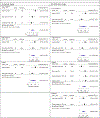Heart rate variability as a biomarker of functional outcomes in persons with acquired brain injury: Systematic review and meta-analysis
- PMID: 34626686
- PMCID: PMC9006352
- DOI: 10.1016/j.neubiorev.2021.10.004
Heart rate variability as a biomarker of functional outcomes in persons with acquired brain injury: Systematic review and meta-analysis
Abstract
This review aimed to quantify correlations between heart rate variability (HRV) and functional outcomes after acquired brain injury (ABI). We conducted a literature search from inception to January 2020 via electronic databases, using search terms with HRV, ABI, and functional outcomes. Meta-analyses included 16 studies with 906 persons with ABI. Results demonstrated significant associations: Low frequency (LF) (r = -0.28) and SDNN (r = -0.33) with neurological function; LF (r = -0.33), High frequency (HF) (r = -0.22), SDNN (r = -0.22), and RMSSD (r = -0.23) with emotional function; and LF (r = 0.34), HF (r = 0.41 to 0.43), SDNN (r = 0.43 to 0.51), and RMSSD (r = 0.46) with behavioral function. Results indicate that higher HRV is related to better neurological, emotional, and behavioral functions after ABI. In addition, persons with stroke showed lower HF (SMD = -0.50) and SDNN (SMD = -0.75) than healthy controls. The findings support the use of HRV as a biomarker to facilitate precise monitoring of post-ABI functions.
Keywords: Biomarker; Brain injuries; Functional outcomes; Heart rate variability; Meta-analysis; Outcome assessment (health care); Stroke.
Copyright © 2021 Elsevier Ltd. All rights reserved.
Figures





Similar articles
-
Heart rate variability in type 2 diabetes mellitus: A systematic review and meta-analysis.PLoS One. 2018 Apr 2;13(4):e0195166. doi: 10.1371/journal.pone.0195166. eCollection 2018. PLoS One. 2018. PMID: 29608603 Free PMC article.
-
The role of heart rate variability in acute mountain sickness: A meta-analysis.Medicine (Baltimore). 2025 Jun 13;104(24):e42692. doi: 10.1097/MD.0000000000042692. Medicine (Baltimore). 2025. PMID: 40527833 Free PMC article.
-
Short-term exposure to particulate matter on heart rate variability in humans: a systematic review of crossover and controlled studies.Environ Sci Pollut Res Int. 2021 Jul;28(27):35528-35536. doi: 10.1007/s11356-021-14494-1. Epub 2021 May 24. Environ Sci Pollut Res Int. 2021. PMID: 34031827
-
Pre- and postoperative heart rate variability and vagus nerve stimulation in patients with drug-resistant epilepsy - A meta-analysis.Epilepsy Behav. 2021 Oct;123:108247. doi: 10.1016/j.yebeh.2021.108247. Epub 2021 Aug 18. Epilepsy Behav. 2021. PMID: 34418640
-
Short-term effects of ultrafine particles on heart rate variability: A systematic review and meta-analysis.Environ Pollut. 2022 Dec 1;314:120245. doi: 10.1016/j.envpol.2022.120245. Epub 2022 Sep 23. Environ Pollut. 2022. PMID: 36162563
Cited by
-
Effects of poststroke heart rate variability on the neurological impairment severity and the prognosis among patients with ischaemic stroke: a scoping review.BMJ Open. 2025 Mar 24;15(3):e092826. doi: 10.1136/bmjopen-2024-092826. BMJ Open. 2025. PMID: 40132838 Free PMC article.
-
An Observational Study of Heart Rate Variability Using Wearable Sensors Provides a Target for Therapeutic Monitoring of Autonomic Dysregulation in Patients with Rett Syndrome.Biomedicines. 2022 Jul 13;10(7):1684. doi: 10.3390/biomedicines10071684. Biomedicines. 2022. PMID: 35884989 Free PMC article.
-
The ECG abnormalities in persons with chronic disorders of consciousness.Med Biol Eng Comput. 2024 Oct;62(10):3013-3023. doi: 10.1007/s11517-024-03129-5. Epub 2024 May 16. Med Biol Eng Comput. 2024. PMID: 38750280
-
Nomogram Based on HRV for Predicting the Therapeutic Effects of Orthostatic Training in Children with Vasovagal Syncope.Children (Basel). 2024 Nov 30;11(12):1467. doi: 10.3390/children11121467. Children (Basel). 2024. PMID: 39767896 Free PMC article.
-
Association between non-acute traumatic injury (TI) and heart rate variability (HRV) in adults: A systematic review protocol.PLoS One. 2022 Aug 26;17(8):e0273688. doi: 10.1371/journal.pone.0273688. eCollection 2022. PLoS One. 2022. PMID: 36026501 Free PMC article.
References
-
- Appelhans BM, Luecken LJ(2006). Heart rate variability as an index of regulated emotional responding. Review of General Psychology, 10, 229–240. 10.1037/1089-2680.10.3.229 - DOI
-
- Bassi A, Colicivvhi F, Santini M, Caltagirone C (2007). Cardiac autonomic dysfunction and functional outcome after ischaemic stroke. European Journal of Neurology, 14, 917–922. - PubMed
Publication types
MeSH terms
Substances
Grants and funding
LinkOut - more resources
Full Text Sources
Research Materials
Miscellaneous

